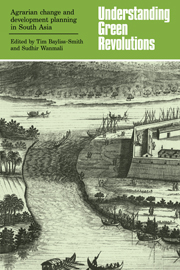Book contents
- Frontmatter
- Contents
- List of contributors
- Preface
- I Understanding Green Revolutions: an overview
- II Agrarian change at village level
- 5 Agrarian policy and agrarian change in tribal India
- 6 Migration and agrarian change in Garhwal District, Uttar Pradesh
- 7 Agricultural development in Tamil Nadu: two decades of land use change at village level
- 8 Energy flows and agrarian change in Karnataka: the Green Revolution at micro-scale
- 9 Income and wealth disparities in a land settlement of the Sri Lanka Dry Zone
- 10 Agrarian structure and agricultural innovation in Bangladesh: Panimara village, Dhaka district
- 11 A structural analysis of two farms in Bangladesh
- III Development planning and agrarian change
- Index
6 - Migration and agrarian change in Garhwal District, Uttar Pradesh
Published online by Cambridge University Press: 25 May 2010
- Frontmatter
- Contents
- List of contributors
- Preface
- I Understanding Green Revolutions: an overview
- II Agrarian change at village level
- 5 Agrarian policy and agrarian change in tribal India
- 6 Migration and agrarian change in Garhwal District, Uttar Pradesh
- 7 Agricultural development in Tamil Nadu: two decades of land use change at village level
- 8 Energy flows and agrarian change in Karnataka: the Green Revolution at micro-scale
- 9 Income and wealth disparities in a land settlement of the Sri Lanka Dry Zone
- 10 Agrarian structure and agricultural innovation in Bangladesh: Panimara village, Dhaka district
- 11 A structural analysis of two farms in Bangladesh
- III Development planning and agrarian change
- Index
Summary
Labour migration has been viewed as an instrument of economic development, transferring labour from a subsistence agricultural sector of low productivity to a capitalist, industrial sector where high productivity, efficiency and profitability are believed to prevail (Lewis, 1954). The key feature of this process is a permanent transfer of labour, labour which is surplus to production requirements in the agricultural sector and which thereby reduces the agricultural sector's total consumption requirement. The resulting surplus of agricultural production over domestic subsistence requirements is believed to provide a source of capital for financing economic improvements in the agricultural sector, for the manufacture of industrial sector products, and for increasing the effective demand for them (Mellor, 1969). In the Himalaya, however, migration and agrarian change have taken on a different guise. The majority of moves undertaken by hill labour are circular in nature, not extending beyond the duration of an individual's working life, and they are a response to declining per capita production levels in the agricultural sector. The purpose of migration is therefore to provide cash support through remittances and pensions earned outside the hill area, for a resident population which operates an agricultural system that is unable to meet its subsistence requirements and which possesses a weak facility for structural transformation.
- Type
- Chapter
- Information
- Understanding Green RevolutionsAgrarian Change and Development Planning in South Asia, pp. 109 - 135Publisher: Cambridge University PressPrint publication year: 1984
- 2
- Cited by



